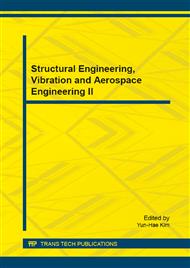p.48
p.53
p.57
p.63
p.68
p.74
p.79
p.84
p.88
Monolayer Cable-Stayed Steel Moment Resistant Frame and its Lateral Force Resisting Performance
Abstract:
A new lateral force resisting system (LFRS), referred to as the monolayer cable-stayed steel moment resistant frame (MCSMRF) system, is proposed in order to improve capacity of original MRF system and reduce lateral displacement of the system effectively. The MCSMRF integrates the respective advantages of both the steel moment resistant frame (MRF) and inclined cables, Likewise, the CSMRF renders both the dual seismic defense line and self-centering capacity. The working mechanism of the CSMRF are introduced. Secondly, the floor displacement (relative to the ground) approximation formula is developed for the MCSMRF under the lateral loading. Eventually, the numerical analysis is made of the MCSMRF with resorting to the developed approximation formula. The results show that the interstorey drift and the floor displacement significantly reduce with respect to the original steel MRF. Approximate calculation formula of elastic floor displacements can provide a theoretical basis for the preliminary design of its components.
Info:
Periodical:
Pages:
68-73
Citation:
Online since:
January 2015
Authors:
Price:
Сopyright:
© 2015 Trans Tech Publications Ltd. All Rights Reserved
Share:
Citation:


